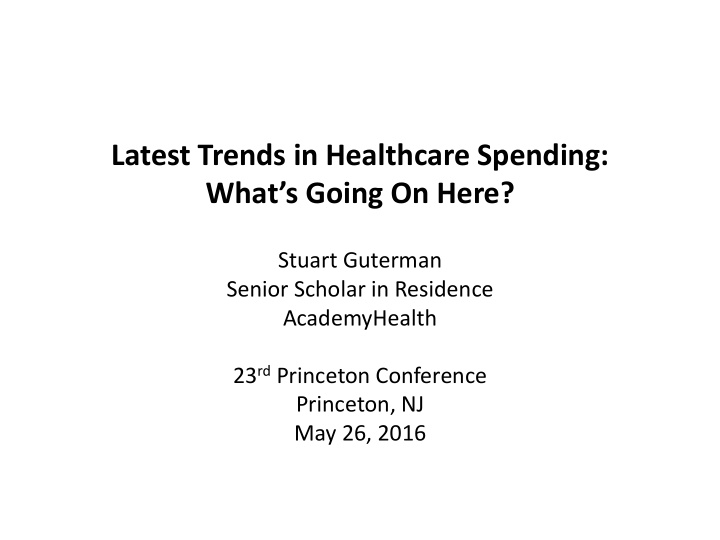



Latest Trends in Healthcare Spending: What’s Going On Here? Stuart Guterman Senior Scholar in Residence AcademyHealth 23 rd Princeton Conference Princeton, NJ May 26, 2016
2 Good News? Source: Melanie Evans. “U.S. Healthcare Spending Growth Hit 53 - Year Low in 2013.” Modern Healthcare , December 3, 2014; available at http://www.modernhealthcare.com/article/20141203/NEWS/312039993
But For How Long?… National Health Expenditure Projections, 2014 – 24: Spending Growth Faster Than Recent Trends Health spending growth in the United States is projected to average 5.8 percent for 2014 –24, reflecting the Affordable Care Act’s coverage expansions, faster economic growth, and population aging. Recent historically low growth rates in the use of medical goods and services, as well as medical prices, are expected to gradually increase. However, in part because of the impact of continued cost-sharing increases that are anticipated among health plans, the acceleration of these growth rates is expected to be modest. The health share of US gross domestic product is projected to rise from 17.4 percent in 2013 to 19.6 percent in 2024. Source: S.P. Keaton et al. “National Health Expenditure Projections, 2014: Spending Growth Faster Than Recent Trends.” Health Affairs August 2015 34(8):1407-17.
The $2 Trillion Question: Why Has Health Spending Slowed? Projected National Health Expenditures (NHE), 2010-2019, as of March 2010 vs. Actual/Projected NHE, 2010-2019, as of August 2015 $ Billions 5000 March 2010 August 2015 4000 3000 2000 Cumulative NHE, 2010-2019: March 2010 projection: $34.1 Trillion 1000 August 2015 (actual 2010-13; projected 2014-19): $32.2 Trillion 0 2010 2011 2012 2013 2014 2015 2016 2017 2018 2019 Sources: C.J. Truffer et al. “Health Spending Projections Through 2019: The Recession’s Impact Continues.” Health Affairs March 2010 29(3):522- 29; S.P. Keaton et al. “National Health Expenditure Projections, 2014: Spending Growth Faster Than Recent Trends.” Health Affairs August 2015 34(8):1407-17.
…and What Does the Future Look Like? Projected and Actual Per Capita NHE Growth, 2008-13 vs. 2013-24 Annual Rate 10% 9% Projected* Actual* 8% 7% 6% 4.9% 4.5% 5% 4% 3.1% ? 3% 2% 1% 0% 2008-2013 2013-2024 Note: Projected growth rate for 2008-2013 is as of March 2010; projected growth rate for 2013-2023 is as of August 2015. Actual growth rate for 2008-2013 is as of August 2015. Sources: C.J. Truffer et al. “Health Spending Projections Through 2019: The Recession’s Impact Continues.” Health Affairs March 2010 29(3):522-29; S.P. Keaton et al. “National Health Expenditure Projections, 2014: Spending Growth Faster Than Recent Trends.” Health Affairs August 2015 34(8):1407-17.
6 What if Health Spending Grew at Same Rate As GDP? Projected cumulative NHE, 2014-2024: $42.4T assuming same growth rate as GDP, compared to $45.3T under CMS’s current NHE projections. 19.6% of GDP $5.5 Still, a 65% increase in health spending over 11 years. Cumulative Difference: $5.0 $2.9 T NHE (in $ Trillions) 17.4% of GDP Based on CMS $4.5 NHE Projection $4.0 $3.5 Actual Growing at same $3.0 rate as GDP $2.5 $2.0 2008 2009 2010 2011 2012 2013 2014 2015 2016 2017 2018 2019 2020 2021 2022 2023 2024 Data Source: Centers for Medicare & Medicaid Services, Office of the Actuary, National Health Statistics Group. 2008-2024 National Health Expenditures, Projected. Available at http://cms.gov/Research-Statistics-Data-and-Systems/Statistics-Trends-and- Reports/NationalHealthExpendData/NationalHealthAccountsProjected.html.
7 Challenges to Controlling Health Spending • Can we maintain or improve quality while controlling costs? • What are the roles of utilization and prices? • What are the roles of drugs and technology? • Can we achieve greater coordination and collaboration without the adverse effects of consolidation? • Can we develop policies that are consistent across public and private payers?
8 What Do We Need to Do to Sustain Slower Health Spending Growth? • Transparency? • Payment reform? • Competition? • Regulation?
Our Panel Charles S. Roehrig Geoffrey C. Sandler Altarum Institute Aetna
Recommend
More recommend